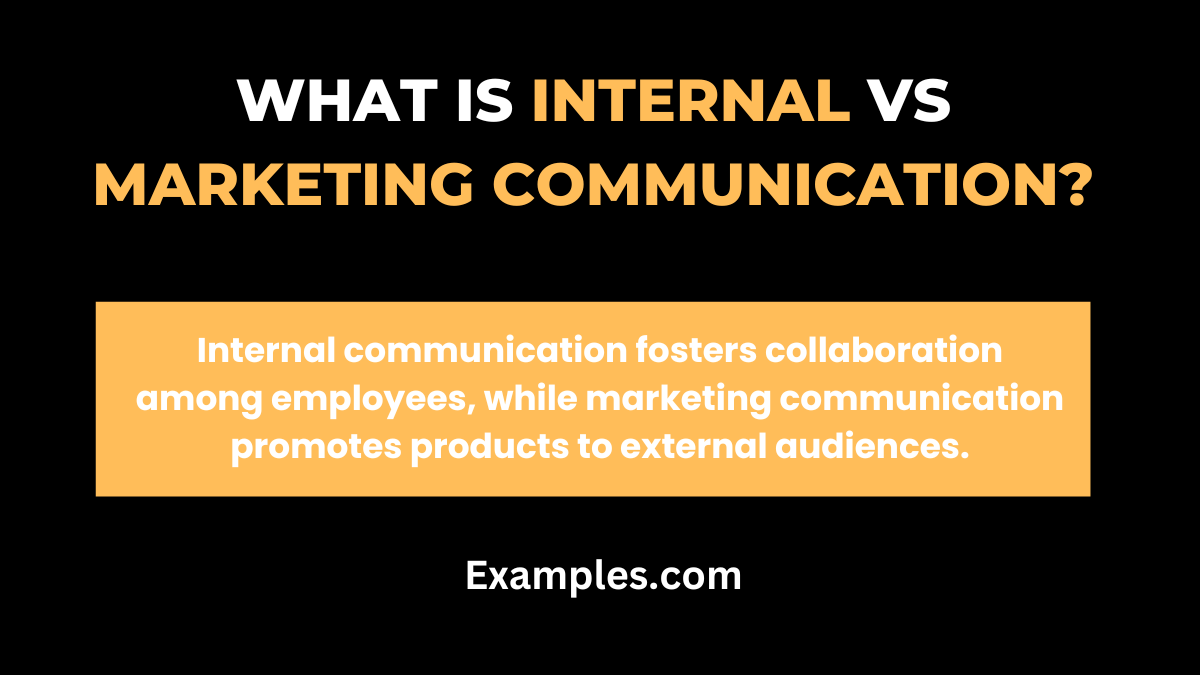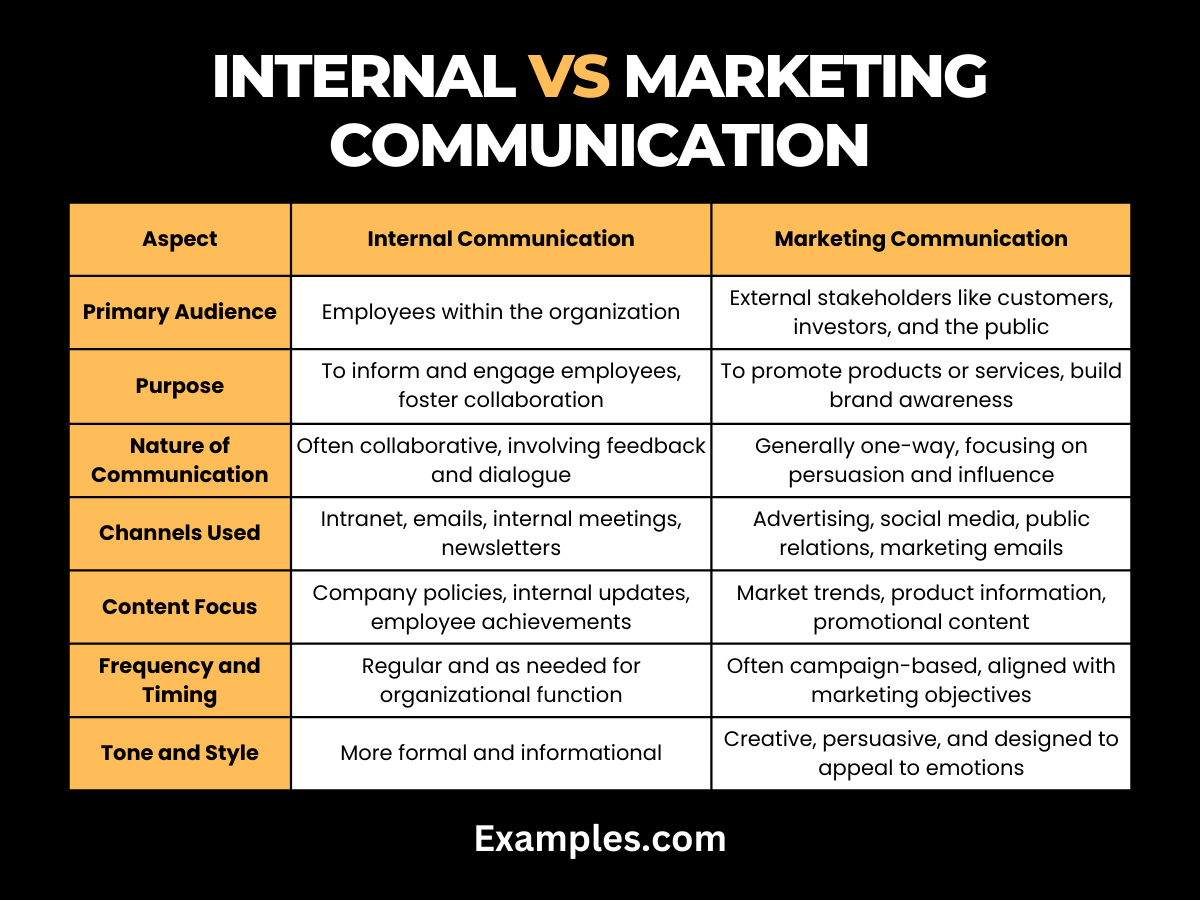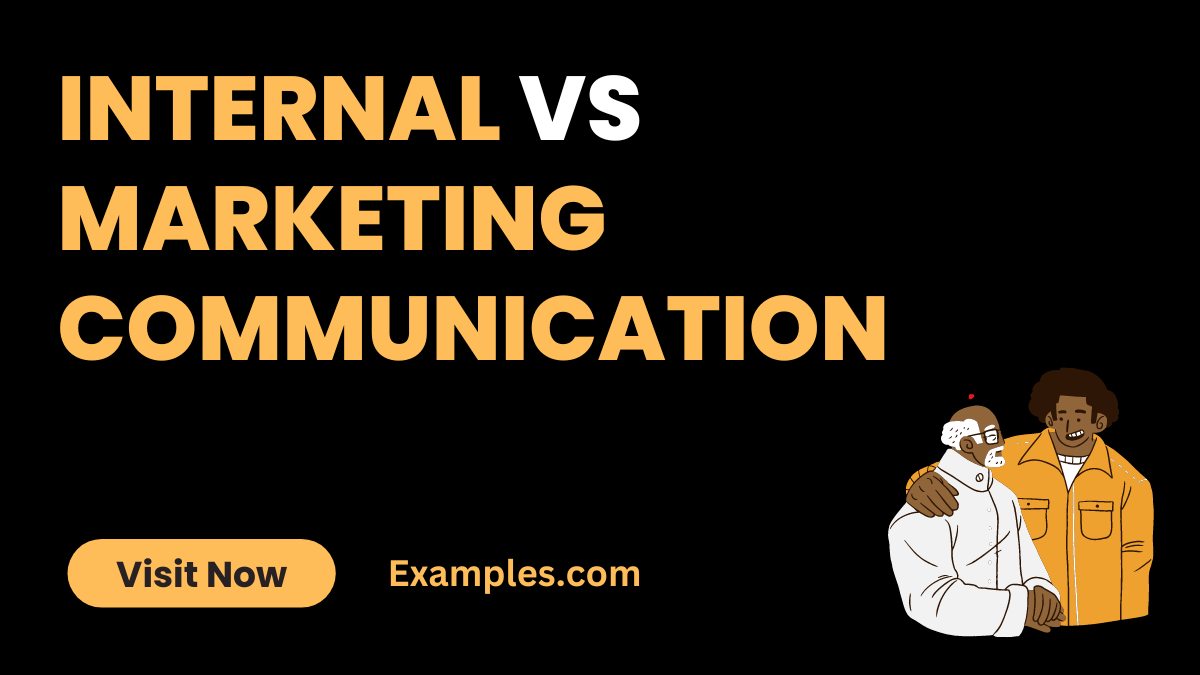Internal vs Marketing Communication – 19+ Examples
Understanding the nuances of internal communication versus marketing communication is crucial for any organization. While internal communication focuses on fostering a strong internal team dynamic, marketing communication aims at promoting a brand’s message externally. This guide offers real-world internal communication examples to illustrate how these two forms of communication differ yet complement each other. Whether it’s aligning your team’s goals or engaging your customers, mastering both forms is key to organizational success.
What is Internal vs Marketing Communication?

Internal vs Marketing Communication refers to distinct strategies within an organization. Internal communication focuses on sharing information, fostering collaboration, and engaging employees within the company. It utilizes tools like intranets and team meetings. In contrast, marketing communication aims to promote products and services to external audiences, primarily customers, using channels like advertising and social media. While internal communication builds a cohesive workforce, marketing communication strives to enhance brand visibility and drive customer engagement.
Difference Between Internal vs Marketing Communication

| Aspect | Internal Communication | Marketing Communication |
|---|---|---|
| Primary Audience | Employees within the organization | External stakeholders like customers, investors, and the public |
| Purpose | To inform and engage employees, foster collaboration | To promote products or services, build brand awareness |
| Nature of Communication | Often collaborative, involving feedback and dialogue | Generally one-way, focusing on persuasion and influence |
| Channels Used | Intranet, emails, internal meetings, newsletters | Advertising, social media, public relations, marketing emails |
| Content Focus | Company policies, internal updates, employee achievements | Market trends, product information, promotional content |
| Frequency and Timing | Regular and as needed for organizational function | Often campaign-based, aligned with marketing objectives |
| Tone and Style | More formal and informational | Creative, persuasive, and designed to appeal to emotions |
| Measurement of Effectiveness | Employee engagement surveys, feedback mechanisms | Sales figures, marketing analytics, public engagement metrics |
| Confidentiality Level | Often contains sensitive internal information | Public-facing and intended for wide dissemination |
| Goal | To maintain an informed and cohesive workforce | To attract and retain customers, and enhance brand loyalty |
10 Examples of Internal Communication
Internal communication is pivotal in creating a cohesive and informed workplace.
- Weekly Team Meetings: Regular meetings keep everyone on the same page.
Example: “Let’s discuss our weekly goals and updates every Monday morning.” - Internal Newsletters: Share company news and celebrate achievements.
Example: “Our monthly newsletter highlights team accomplishments and important updates.” - Feedback Surveys: Collecting employee feedback for continuous improvement.
Example: “Please fill out the quarterly survey to share your thoughts on our work environment.” - Company Intranet: A centralized hub for resources and information.
Example: “You can find all HR policies and project documents on our intranet.” - Employee Recognition Programs: Acknowledging team efforts and successes.
Example: “Congratulations to our Employee of the Month, featured in our internal portal.” - Emergency Communication System: For urgent updates and safety alerts.
Example: “In case of an emergency, you’ll receive real-time alerts via our messaging system.” - Digital Collaboration Tools: Enhancing teamwork and project management.
Example: “Use our collaboration platform for real-time project discussions and updates.” - Social Media Groups: Informal platforms for team bonding and communication.
Example: “Join our company’s Facebook group to connect and share ideas.” - Training and Development Sessions: Promoting growth and skill enhancement.
Example: “Attend our monthly training webinars to learn new industry practices.” - Management Open Doors Policy: Encouraging open communication with leadership.
Example: “Feel free to discuss any concerns with your manager during open hours.”
10 Examples of Marketing Communication
Marketing communication plays a vital role in connecting with and persuading potential customers. Here are 10 distinct examples:
- Social Media Campaigns: Engaging with audiences on popular platforms.
Example: “Our new product launch will be teased through a series of Instagram posts.” - Email Marketing: Personalized communication with subscribers.
Example: “Our weekly newsletter offers exclusive deals and insights into our services.” - Content Marketing: Educating and engaging customers through content.
Example: “Check out our blog for tips on how to use our products effectively.” - Public Relations Events: Building brand image and awareness.
Example: “Join us at the annual trade show to experience our latest innovations.” - Influencer Collaborations: Leveraging influencers for brand promotion.
Example: “We’ve partnered with lifestyle bloggers to showcase our new fashion line.” - SEO Strategies: Optimizing web content for search engines.
Example: “Our articles include keywords to improve our visibility on search engines.” - Customer Testimonials: Showcasing positive reviews and experiences.
Example: “Read our customer success stories on our website to see real-life impacts.” - Direct Mail Campaigns: Reaching customers through physical mail.
Example: “Our catalog with the latest products will be mailed to our loyal customers.” - Webinars and Online Events: Educating and engaging with the audience virtually.
Example: “Register for our free webinar on industry trends and insights.” - Billboard Advertising: Capturing attention through outdoor advertising.
Example: “Our eye-catching billboard on Main Street highlights our brand’s message.”
Comparison Between Internal vs Marketing Communication
- Audience: Internal communication targets employees, while marketing communication is directed at potential and existing customers.
Example: An internal email about a company event vs. a social media ad about a new product. - Content: The content of internal communication is often informative and focuses on organizational matters, whereas marketing communication is persuasive, focusing on products and services.
Example: A memo on policy changes vs. a brochure highlighting product features. - Purpose and Goals: Internal communication aims to inform and engage employees, while marketing communication seeks to promote and sell.
Example: An internal newsletter celebrating employee achievements vs. an email campaign for a seasonal sale. - Channels: Different channels are used; internal communication may utilize intranets or team meetings, whereas marketing communication often uses public platforms like social media.
Example: A company-wide virtual meeting vs. a Facebook marketing campaign. - Direction of Communication: Internal communication is often two-way, encouraging dialogue. Marketing communication is typically one-way, broadcasting to the audience.
Example: An interactive internal Q&A session vs. a television advertisement. - Style and Tone: Internal communication tends to be more formal and direct, while marketing communication is more creative and emotionally appealing.
Example: A straightforward internal report on financial results vs. a storytelling approach in a marketing video. - Frequency and Planning: Internal communication is regular and consistent, while marketing communication is often campaign-based and seasonal.
Example: Weekly internal updates vs. a holiday season marketing campaign. - Confidentiality: Internal communication often contains sensitive information not meant for public consumption, unlike marketing communication.
Example: Sharing of internal financial targets vs. publicizing a promotional offer. - Feedback Mechanisms: Internal communication involves feedback loops with employees, while marketing communication focuses on customer reactions and sales metrics.
Example: An employee survey vs. customer reviews and sales data analysis. - Measurement of Effectiveness: Different metrics are used to measure effectiveness; employee engagement for internal communication, and market reach and sales for marketing communication.
Example: Analyzing employee survey results vs. evaluating the ROI of a marketing campaign.
Relationship Between Internal vs Marketing Communication
- Alignment of Messages: Both types of communication should align to ensure consistency in company messaging.
Example: Company values promoted internally should reflect in external marketing efforts. - Employee as Brand Ambassadors: Effective internal communication can turn employees into brand ambassadors for marketing.
Example: Employees sharing their positive work experiences on social media, enhancing the brand image. - Feedback Loop: Feedback from marketing communication can inform internal strategies and vice versa. Example: Customer feedback shaping internal training programs for better service.
- Shared Goals: Both aim to enhance the company’s reputation, albeit in different arenas.
Example: Internal communication fostering a positive work culture, which reflects well in external marketing campaigns. - Crisis Management: In a crisis, internal and marketing communication must work together to manage the company’s public image.
Example: Coordinated internal and external messages during a product recall. - Cross-functional Collaboration: Collaborations between internal and marketing teams can lead to more cohesive communication strategies.
Example: Joint meetings between HR and marketing departments to discuss brand values. - Training and Development: Marketing strategies can be used internally to educate employees about products and services.
Example: Using marketing materials for internal training sessions. - Consistency in Brand Voice: A consistent brand voice across internal and marketing communication strengthens brand identity.
Example: Similar tone and language in internal memos and external ad campaigns. - Change Management: Effective internal communication helps employees understand and support marketing strategies.
Example: Internal briefings on a new marketing initiative to garner employee support. - Employee Insight for Marketing Strategies: Employees’ insights can provide valuable input for marketing strategies.
Example: Employee feedback contributing to the development of customer-centric marketing plans.
Understanding the distinctions and interconnections between internal and marketing communication is vital for organizational coherence and effectiveness. While they serve different audiences and purposes, their strategic alignment is crucial. Recognizing their unique roles and leveraging their relationship can significantly enhance overall communication effectiveness, employee engagement, and brand strength.



